| |||||||
| Search Forums |
| Advanced Search |
| Go to Page... |
 |
| Search this Thread |  31,700 views |
| | #1 |
| Distinguished - BHPian  Join Date: Aug 2014 Location: Delhi-NCR
Posts: 4,078
Thanked: 64,556 Times
| Indian Aviation: Helicopters of the Indian Armed Forces Helicopters of the Indian Armed ForcesINTRODUCTIONA helicopter is a type of rotary wing craft in which lift and thrust are supplied by horizontally spinning rotors. This allows the helicopter to take off and land vertically, to hover, and to fly forward, backward and sideways. It is called a rotary wing aircraft because the rotors are literally the wings of the machine. Helicopter rotors are marvels of mechanical engineering and aerofoil design. A helicopter in flight is a choreographed performance of asymmetry. The aerodynamics of a helicopter limit its speed by physics to around 400 kmph though practically production helicopters max out at ~320 kmph. The highest any helicopter has ever climbed to is ~40,000 feet achieved by Aerospatiale Lama known in India as the HAL Cheetah. Most helicopters have an endurance of around 2 hours to 4 hours. And operating speeds, as opposed to top speeds, are usually in the range of 65 to 150 knots {~120 kmph to 275 kmph}. The cost of vertical take-off, hover, flying backwards etc comes at a significant cost. Weight for weight, engine power for engine power a helicopter carries less than half the payload and flies at one-third of the speed of a fixed wing of similar, power & technology. In simple terms a fixed wing has two devices - one to lift it {the wings} and one to move it forward {the jet engines}. In a helicopter the main rotor does the job of both. Give or take a few we have about 800 helicopters in service with the Indian Armed Forces {the IAF, Naval Air Arm, Army Aviation Corps, Coast Guard} and further 200+ or order. We have four Indian designs currently in production - Dhruv, transport & multi-purpose; Prachand, attack & armed reconnaissance; HAL LUH -light utility helicopter; Rudra - attack & armed transport. HISTORY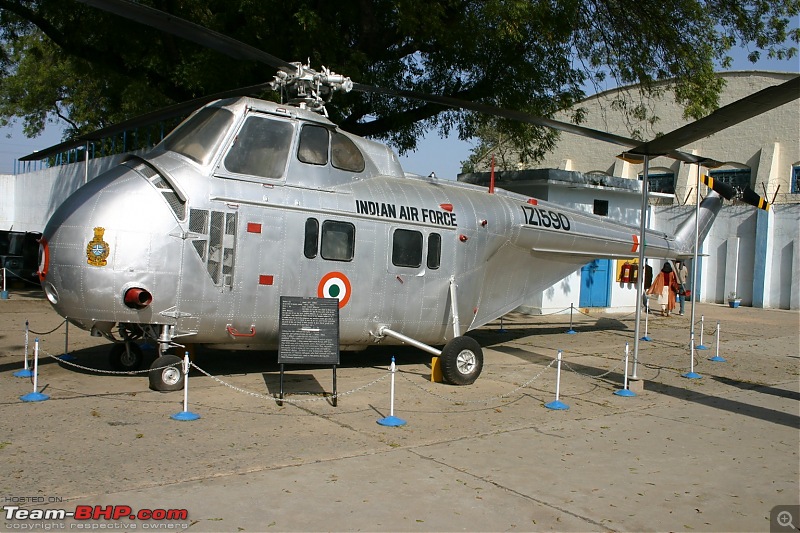 Rotary wing aviation came to the IAF, in 1954, with 8 Sikorsky S-55 medium helicopters supplied by USA. This was a 3-tonne class helicopter that could move 10 troops at a time. A very decent performance for that era. But our dwindling Forex reserves, small defence budgets and our geo-political balance meant our direction needed to shift to USSR and France. And the start of the 1960s brought to our skies two superb and legendary aircraft the Mil Mi-4 and the Aerospatiale Alouette III. 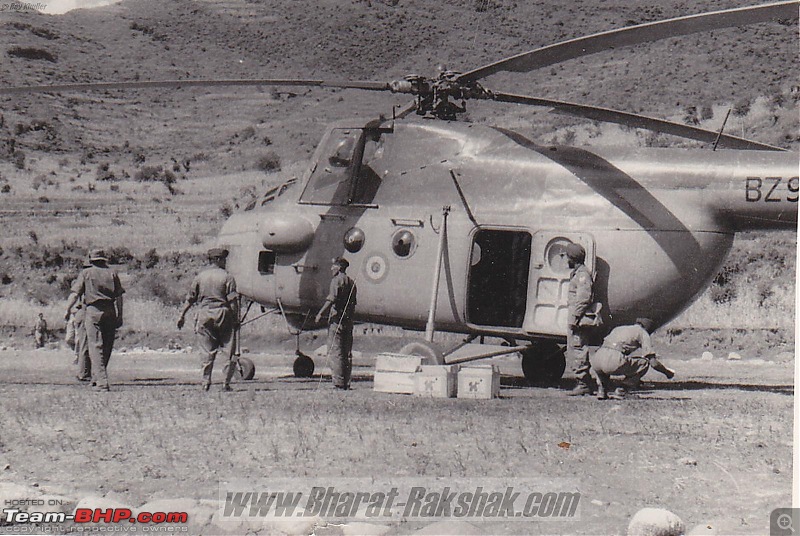 The Mil Mi-4 was USSR's staple medium helicopter of the 1950s to 1970s period. They supplied us with 121 at rock bottom prices paid for in INR. It is rare as the dodo bird in being powered by a ~1600 shp piston engine! Capable of carrying 16 troops or 1.6 tonnes of cargo over a radius of 200+ kms it was the back bone of our helicopter fleet in both the 1965 and 1971 Indo-Pak wars. In the latter the Mi-4 was the vehicle for our river jumping campaign in then East Pakistan that caught the enemy by surprise. Two outstanding operations were the heavy lift across the wide Meghna river and another that dropped an entire battalion {about 900 troops} to the outskirts of Sylhet town. This rugged machine laid the foundation of our heavy vertical lift capability. 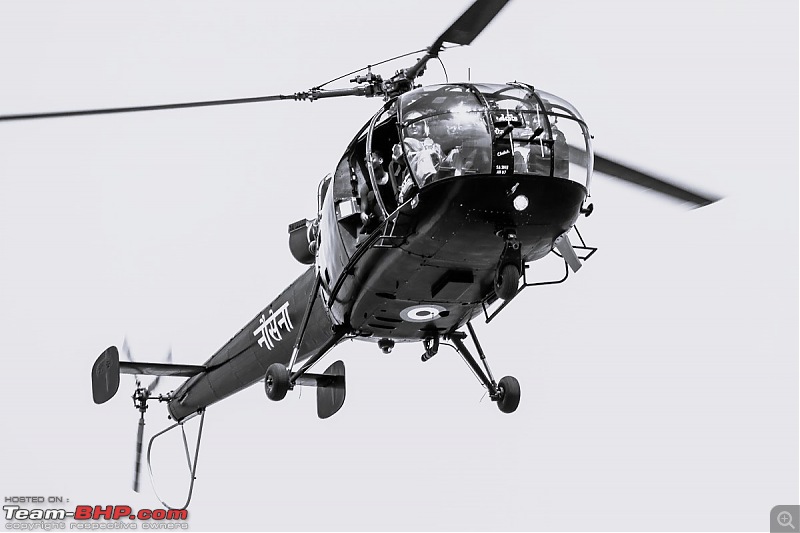 At the other end of the scale was the smaller but equally reliable Alouette III a world beater that saw service with over 70 air arms. A small 2-tonne multi-purpose light chopper the Alouette was built at HAL for all four armed forces and used in a multitude of roles - light transport, recce, shipboard anti-submarine role, coastguard patrol, air to sea rescue, pollution sweeping at sea, light attack with the Army, as a trainer, mountain rescue and more. The Alouette III is only now after 60 years being replaced by the Dhruv. These two aviation classics, the Mil Mi-4 and the Alouette III laid the basis of our 800 strong rotary wing fleet of today. May their rotors hum forever. DHRUV ALHThe good looking HAL Dhruv can be called the single most successful Indian aircraft design ever. Other than spawning several variants for the Army, Navy, Air Force, Coast Guard, Border Security Force and Geological Survey of India it has also fathered the Rudra & the Prachand. 335 Dhruv's have been produced and about ~100 more are on order. All in all a stable reliable helicopter of the 5 to 6 tonne class. The Dhruv was developed initially in collaboration with the German firm MBB and the prototype flew in 1992. The economic crises of the 1990s, Pokhran-II sanctions delayed the development and entry to service till 2002. This section covers only the basic Dhruv, the transport helicopter. Its derivatives, Rudra and Prachand and its sea going variants are covered separately. 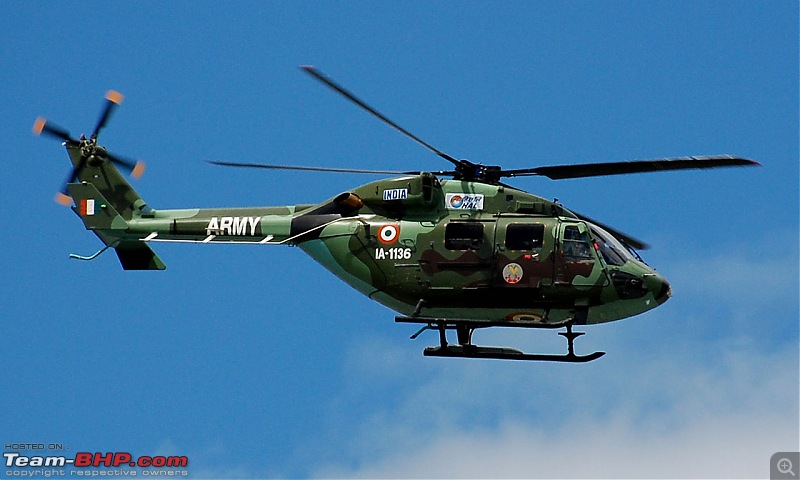 Today the contemporary version is the Mark 3 and its variants powered by the more powerful Shakti turboshaft, an electronic warfare suite, chaff dispensers and improved vibration dampening systems. The Dhruv has designed in crumple zones and crash resistant crew seats to improve survivability and navigation systems including night vision devices to operate in adverse weather conditions. Power is from two Shakti turboshafts turning 1432 shp each giving this 5.8 tonne, at maximum weight, machine an excellent power to weight ratio of ~0.49. 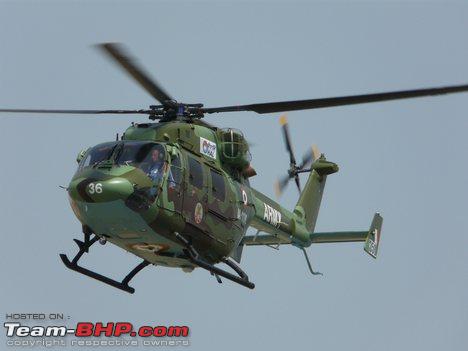 The Dhruv carries a payload of upto 14 troops, 11 is more normal with full gear or 1500 kgs of payload. Range 630 kms. Top speed 250 kmph. Ceiling 20,000 feet. It is fitted with a ramp rear door that facilitates loading. Its initial climb rate at sea level of over 2000 feet a minute is quite exceptional for a helicopter. 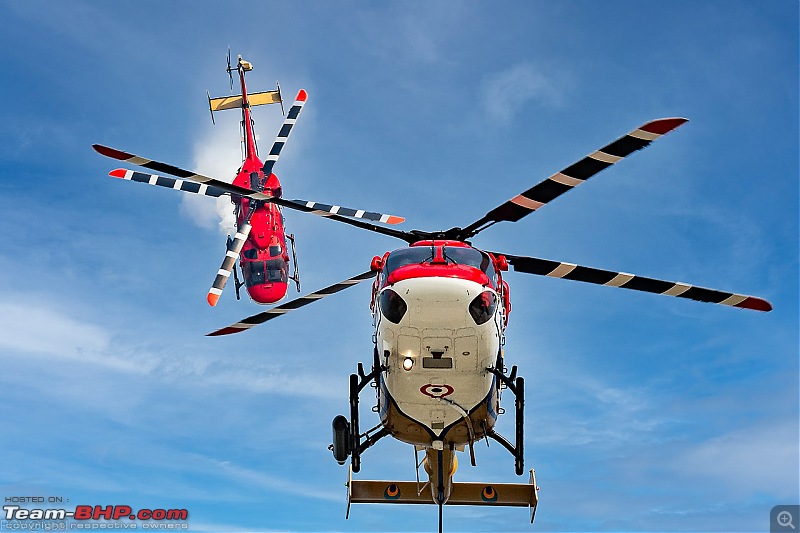 Dhruv is the platform of the IAF helicopter aerobatic team, Sarang. 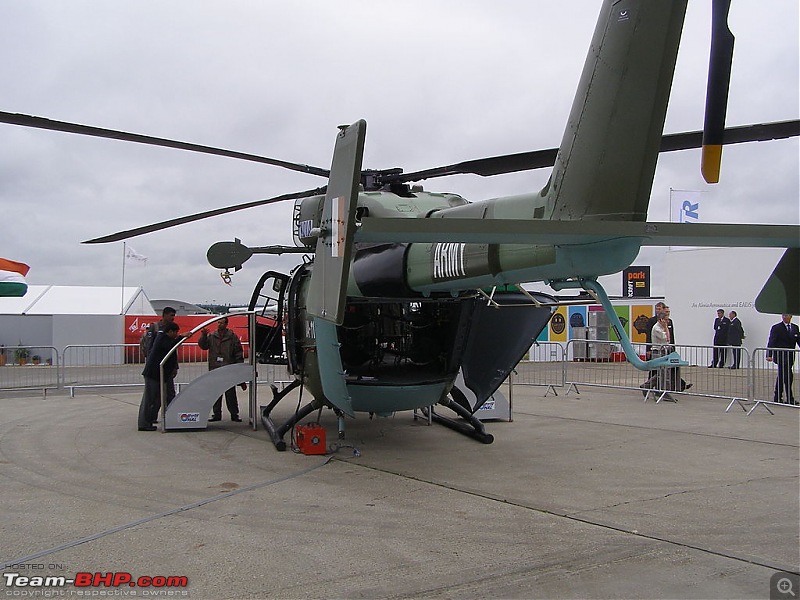 Rear ramp door in action. Note the stabilizer just a head of the tail rotor and the tail strike protector. The Dhruv is a great case study of sensible achievable specifications being drawn up combined with a willingness to collaborate with MBB for the helicopter, with Turbomeca for the engines and purchasing off the shelf proven avionics and getting the machine into service in a reasonable time. Quite unlike the way Tejas Light Combat Aircraft or the Arjun Main Battle Tank started with sky is the limit specs and a impractical aim that everything from the engine and weapon systems to chobham style armour will be developed from scratch in India. ATTACKAn attack helicopter is an armed helicopter with the primary role of an attack aircraft, with the offensive capability of engaging ground targets such as enemy infantry, military vehicles and fortifications. Due to their heavy armament they are sometimes called helicopter gunships. Attack helicopters can use weapons including autocannons, machine guns, rockets, and anti-tank guided missiles. Some attack helicopters are also capable of carrying heat seeking air-to-air missiles, purposes of self-defense against other helicopters and low-flying light combat aircraft. A modern attack helicopter has two primary roles: first, to provide direct and accurate close air support for ground troops; and second, the anti-tank role to destroy grouped enemy armor. Attack helicopters are also used as protective escort for transport helicopters. In US Army calculations, an attack helicopter is projected to destroy targets worth around 17 times its own production cost before being destroyed. Typical design characteristics of an attack helicopter are - twin engines, a high power to weight ratio, tandem cockpits so that both crewmen can enjoy a 300 degree vision, light armour over engines, cockpit, protected fuel tanks, stub wings for extra lift plus weapon pylons and manoeuverability & speed. They are effectively flying tanks relying on speed and manoeuverability to protect themselves. Typical weapons of an attack helicopter are - a chin mounted gun, typically 12.7mm to 30mm in calibre; anti-tank guided weapons; unguided rockets of 57mm to 80mm calibre which come with different warheads - anti-personnel, anti-tank, bunker busting, incendiary; heat seeking air-to-air missiles; gun pods and other air-to-ground guided missiles such as Hellfire, Maverick. It can always carry smaller iron bombs but those are not the best suited for launch from a chopper that might not have much forward speed. Mil Mi-25 Soviet Heavy Attack helicopter 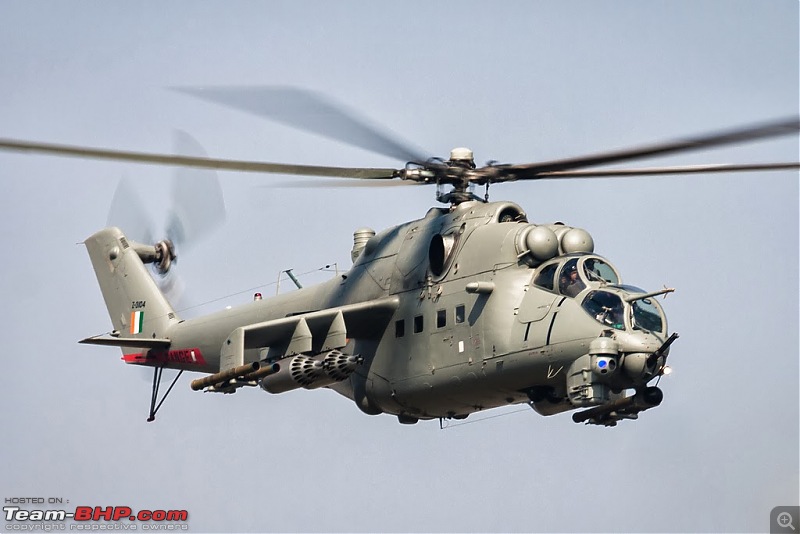 India got introduced to attack helicopters via the legendary Soviet Mil Mi-25. The Mi-25 was heavily armoured, low manoeuverability, high payload attack helicopter that could carry a squad of troops in the main cabin and drop them into the thick of battle at vantage points. This 12-tonne aircraft, derived, from the transport Mi-8 was built around rapid advance concepts for the North European plains. It remains the heaviest attack helicopter ever to be put into service. It did do quite well in numerous conflicts across the globe. But with the IAF the Mi-25's hot and high capability proved inadequate for our Northern borders and we only commissioned two squadrons. Currently ~15 are still in service. Powered by 2 Isotov 2200 shp engines it can clock a very fast 335 kmph and has an endurance of about 2 hours on a combat mission. Its weapon payload of 1500 kgs is the highest for any attack helicopter. Rugged & reliable it is a pity it was too heavy {or under powered} for our needs. Rudra First Indian attack helicopter 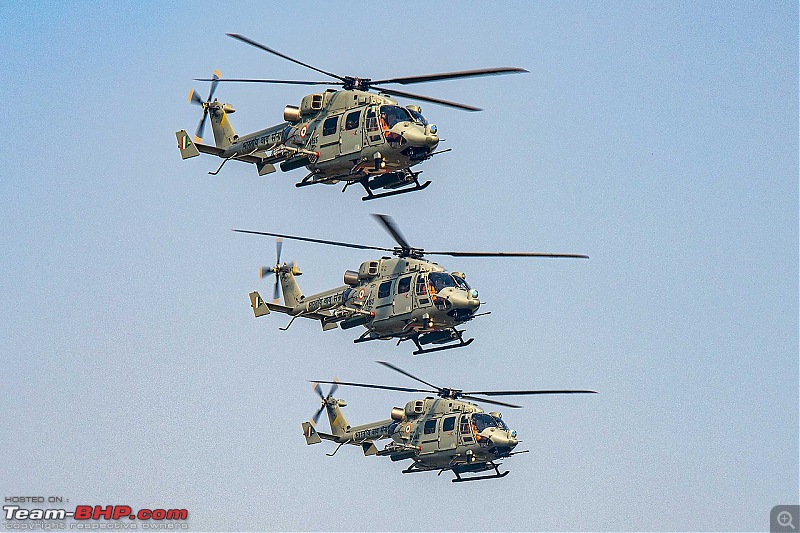 The inadequacy of the Mil Mi-25 and the fall of the USSR forced us to think of developing our own attack helicopter. After the Dhruv platform had completed its user acceptance trials India decided to follow at two step approach to developing its own attack hellicopter. Step 1 was the Rudra a fully armed Dhruv if you may and Step 2 was the real McCoy with the Prachand, also called LCH {Light Combat Helicopter}. Sensible approach. Rudra retained the basic airframe of the Dhruv and mated it with weapon stations, a chin gun and suite of sensors and fire control systems. 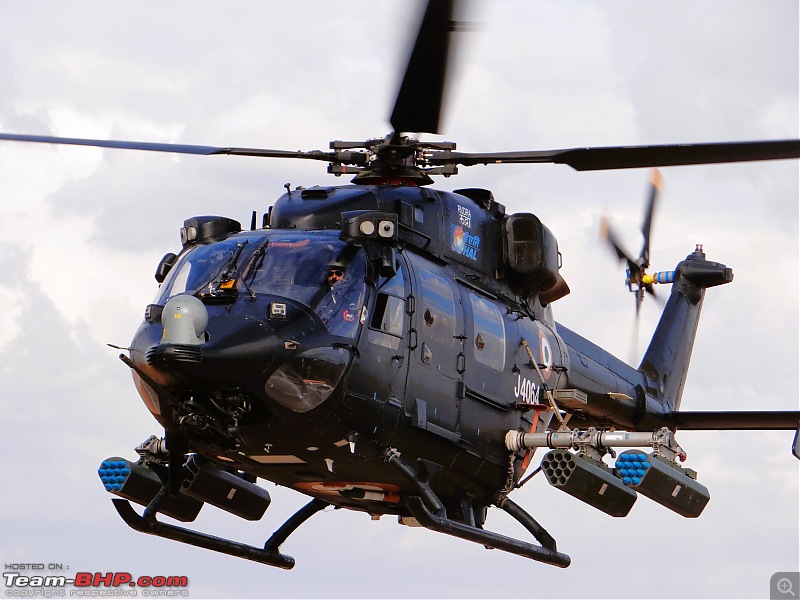 The Rudra is a 5.8 tonne helicopter powered by two HAL-Turbomecca shakti turboshafts developing 2900 shp together giving it a very sound power to weight ratio of 0.493 which accounts for its superb hot and high performance. Its fuel load of 1.05 tonnes gives it a realistic endurance of 2 hours in attack mode or a ferry range at optimum cruise of 630 kms. Its top speed is a respectable 280 kmph married to a service ceiling of 20,000+ feet and a climb rate of 2033 feet/minute. 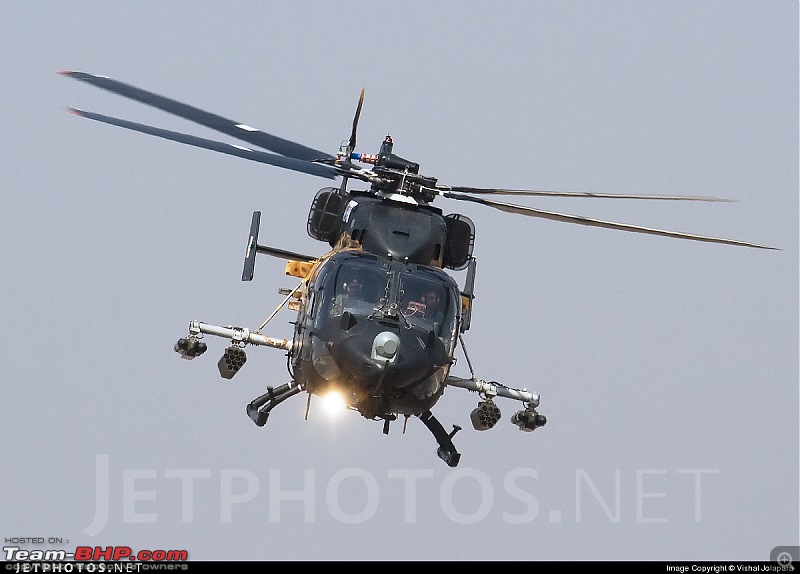 The Rudra carries a French 20mm Nexter cannon in the chin and four hardpoints for a mix of anti-tank guided weapons, 70mm Hydra rockets and the 6 kms range Mistral heat seeking air-to-air missiles. It also carries up to 48 Thales 70mm laser guided rockets, the FZ.275 with a range from 1.5 to 8.0 kms. The Rudra is equipped with forward looking infrared (FLIR), day-and-night optical cameras, and a Thermal Imaging Sights Interface. It is also equipped with an Israeli opto-electronic suite for reconnaissance and target acquisition, a radar warning system, a laser warning system and a missile approach warning system. India has ~90 Rudra in service with a further 75 or order. The Rudra has clocked in a very respectable record in service so far and further production will go to its successor the Prachand described below. I do not know if the small scale of orders is set by budgets or HAL's production capacity. Given the increasing sophistication on our Northern orders we could easily need more than twice these numbers. Given that the LCA Tejas got interminably delayed the Rudra {entered service, 2012} can be called India's third home grown combat aircraft, fixed or rotary, after the HF-24 Marut {service entry, 1967} and HAL Ajeet {service entry, 1977} that achieved squadron service. The significant experience gained on the Rudra was put to good use to develop step 2 of the plan - the Prachand, Light Combat Helicopter. HAL Prachand Future mainstay of India's attack helicopter fleet 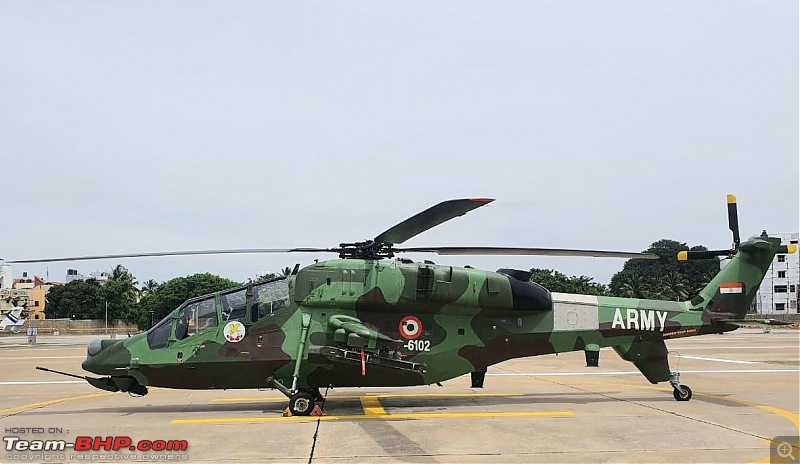 Light Combat Helicopter Prachand is an evolutionary upgrade from the Rudra, retaining the powertrain, sensors, weapons suite, avionics but modifying the hull, cockpit ergonomics and increasing the weapon payload. Powered by two possibly a new variant of the HAL Turbomeca Shakti turboshafts of undisclosed shp output but quite likely to be 1400+shp each. 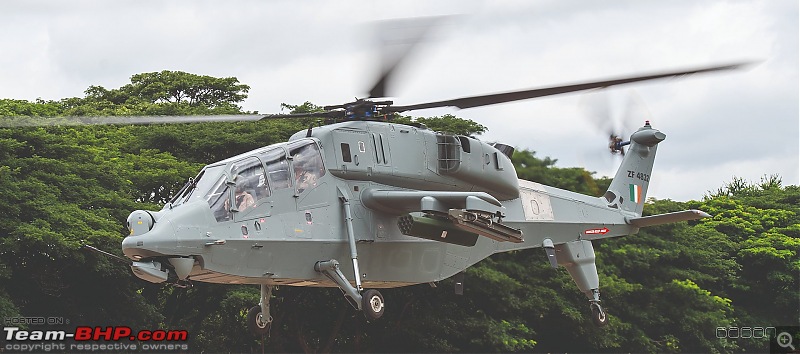 If you observe the LCH helicopter it has all the attributes of an attack machine - from front to back – a narrow fuselage, the chin mounted 20mm Nexter gun, the nose mounted sensors, the tandem seating in armoured crash resistant seats behind thickened transparencies, the stub wings that enhance lift and carry the guided and unguided missiles/rockets and other munitions, the crash absorbing main landing gear, upturned engine exhausts {to reduce infra red signature as seen by a heat seeking missile fired by enemy ground troops}. The Prachand has a top speed of 145 knots {268 kmph}, a service ceiling of 6500 metres {21,300 feet} and an endurance of over 3 hours. 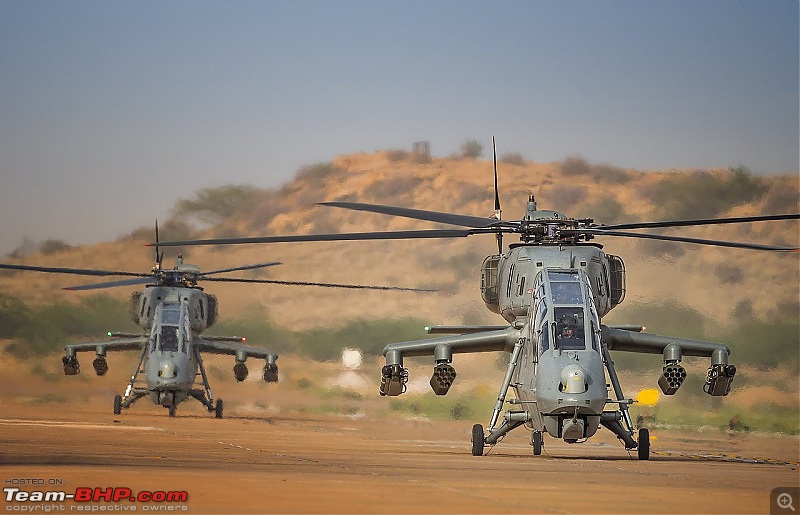 These four pylons mounted on the stub wings can carry a range of munitions - the ones made public are - FN 70mm unguided rockets, a Thales equivalent 70mm rocket that is laser guided, Mistral heat seeking air-to-air missile, Cluster sub-munitions, Grenade launchers and anti-tank guided missiles. Its armament carrying capability while not fully publicized seems significantly greater than the Rudra. 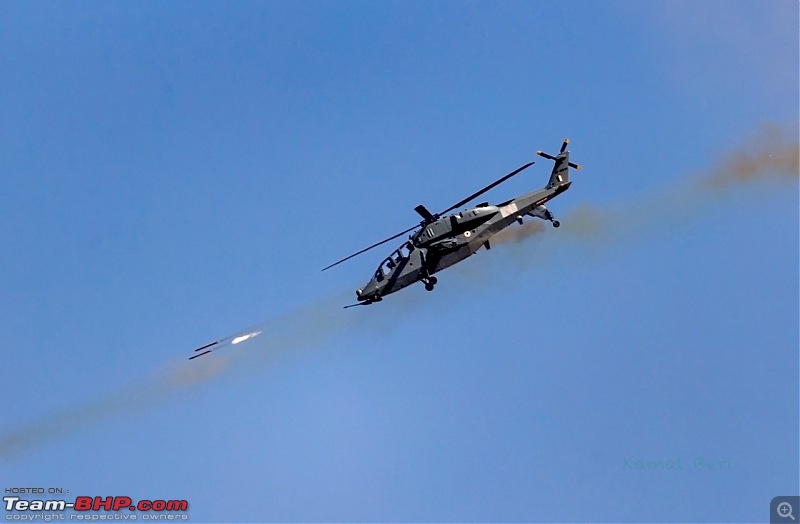 The LCH is furnished with a glass cockpit which accommodates an Integrated Avionics and Display System (IADS) which works in conjunction with the onboard target acquisition and designation (TADS) system linked to the helmet mounted sight (HMS). The TADS and HMS are the principal instruments for targeting and triggering the rotorcraft's armaments. The LCH is protected by a comprehensive electronic warfare suite which, among other pieces, includes a radar warning receiver, laser warning receiver and a missile approach warning system. Other major avionics on board are an integrated data link for network-centric operations, low light TV camera, forward looking infrared (FLIR) imaging sensor, a laser rangefinder and a laser target designator to facilitate target acquisition and kill under all-weather day and night conditions. The Prachand, India's pride - a short video Thread on Prachand by blackwasp Boeing AH-64E The supreme attack helicopter flying today 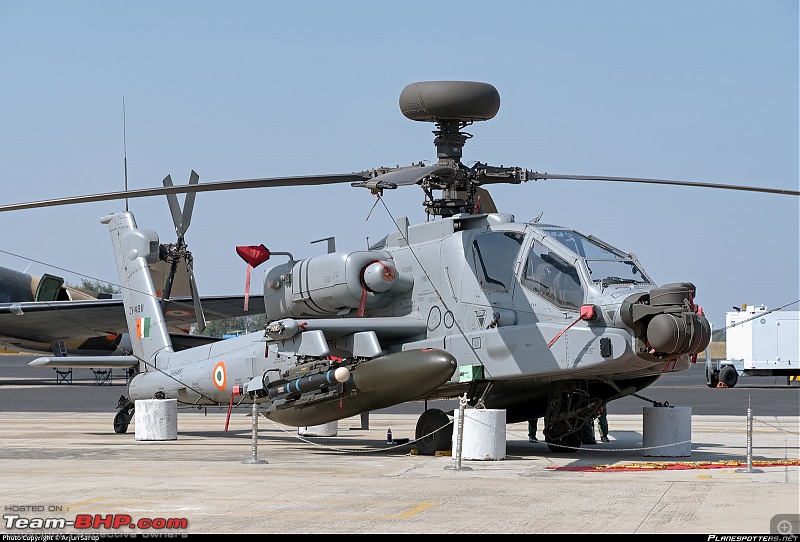 India has 22 AH-64E attack helicopters and 6 on order. A rather small number to put it politely. It is the most seasoned attack chopper in the world in respect of battle proven performance, reliability in all climes and a solid logistics supply chain to service the users. Other than the top class avionics pack it has 1100 kgs of armour or protection systems to survive a hit including blades that can continue to function, albeit less effectively even after a hit by a 23mm cannon shell. Powered by 2 GE turboshafts turning out a combined 4000 shp the AH-64E has a top speed of ~290 kmph and a combat radius of 225 km. 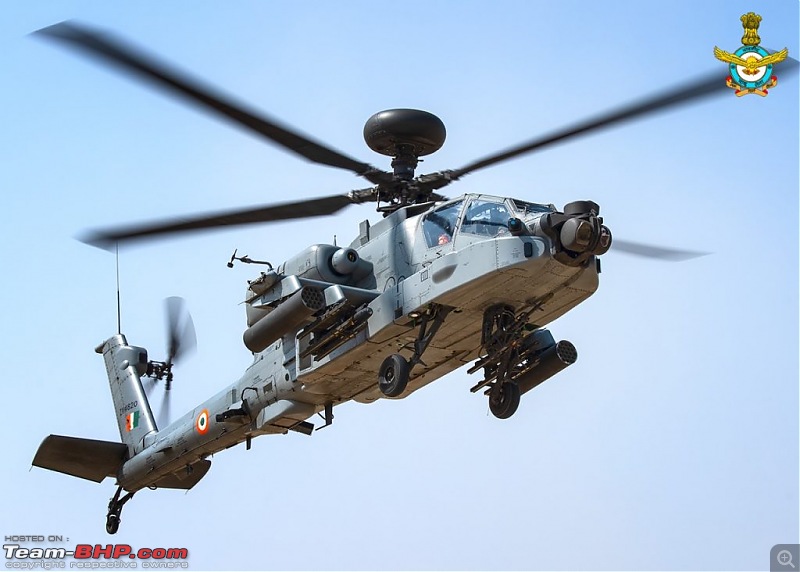 The weapon payload is as with all attack helicopters - 30mm chain gun, anti-tank guided missiles, unguided rockets and Hellfire laser guided missiles, and heat seeking air-to-air missiles. Its greatest asset is the Longbow radar atop the mast which allows the helicopter to detect and engage targets while hovering out of sight behind a natural obstacle. The radar can engage 16 targets simultaneously and has a data link where other Apache helicopters can attack a target spotted and tracked by any one of them. A sad reflection of our inter-service rivalry - the IAF fleet of 22 cost ~Rs 700 crores apiece all told. The much later Indian Army order of a paltry 6 machines will cost us Rs 1100 crores a piece partly due to lack of order size and depreciation of the INR. If only all 28 had been ordered as one deal! Thread on AH-64 by embee TRANSPORTTransport helicopters are used for transporting troops, field guns, ammunition, supplies and even light vehicles in support of military operations without requiring a runway for take-offs and landings. Cargo is carried either internally, or externally by slung load. With our Armed Forces transport helicopters are used for maintaining an airbridge to thousands of manned outposts in the Himalayas or for air assault. Air assault is a military strategy that uses transport helicopters to rapidly move and drop a customized assault force of the Army to a landing zone. The idea is to use the helicopters to transport and land a large number of troops and equipment in a relatively short amount of time, in order to assault and overwhelm an objective. Helicopters in the assault role are generally armed for self-protection both in transit and for suppression of the landing zone. This armament may be in the form of door gunners, or the modification of the helicopter with stub wings and pylons to carry missiles and rocket pods. The Army & the IAF operate a large fleet of about 525 transport helicopters of both the large, medium and medium light categories. Given the belligerence on our Northern borders with China we probably need 100 more of the larger types - Mi-17's and Chinook's described below. Mil Mi-17V The World's most produced helicopter 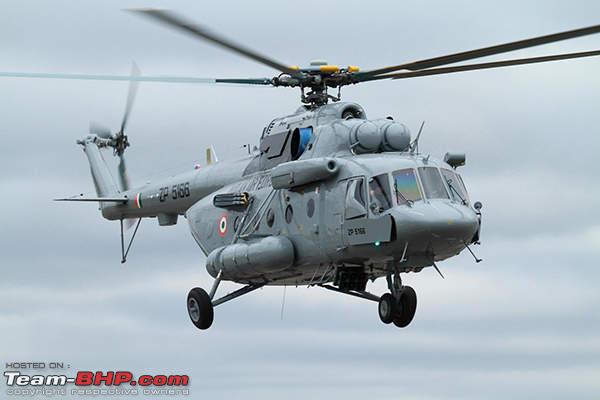 The Mil Mi-17V forms the backbone of our transport fleet with approximately 225 in service. It is an outstanding helicopter in build, reliability, payload and operations in hot and high conditions. Powered by two Klimov turboshaft engines turning out 2400 shp each it can carry a cargo payload of 4000 kgs/24 troops in the cabin or 5000 kgs slung. A clamshell cargo door at the rear allows small vehicles & heavy wheeled mortars to be loaded. 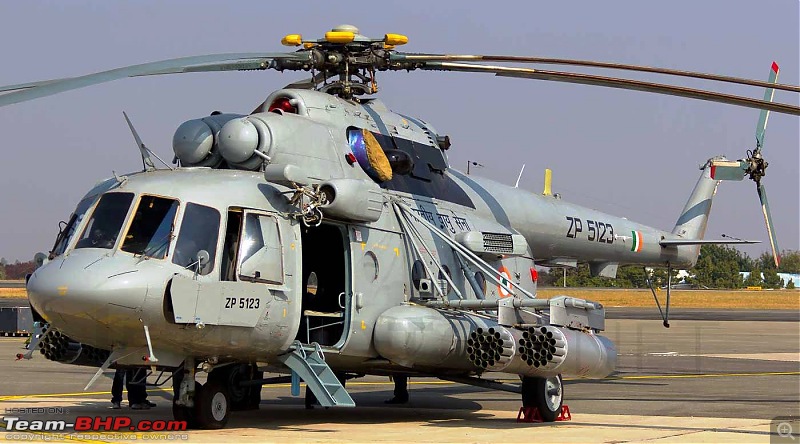 To suppress the enemy at and around the landing zones in addition to the payload it can be armed with 57mm or 80mm rocket pods, anti-tank guided missiles, machineguns or 23mm cannon pods. In fact its armament can match or best that of most dedicated attack helicopters. Seen here with 4 rocket pods, electronic defences in the pods under tail boom and infra red chaff launchers, at the top rear end of the cabin, to defend against heat seeking missiles. 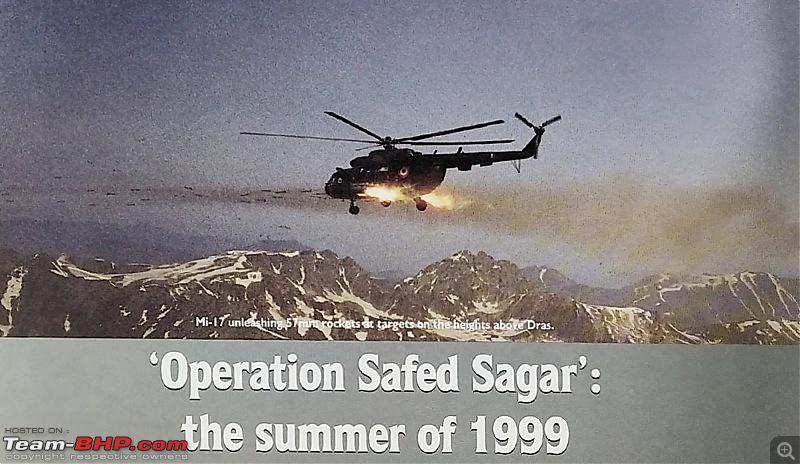 In the Kargil war of 1999, the Mi-17 was the only helicopter that could carry a useful payload of rocket munitions to the high altitudes of 18,000 to 20,000 feet and provide direct suppressive fire for our troops. Boeing Chinook CH-47F Twin rotor heavy lifter 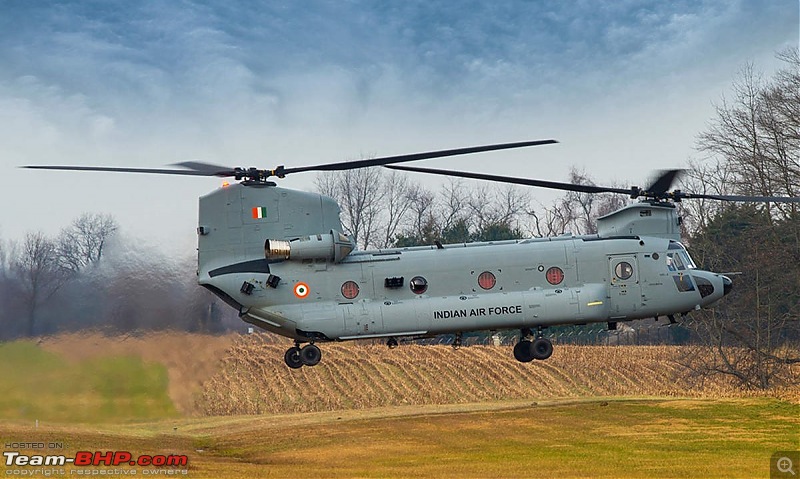 The Boeing Chinook CH-47 is the world's most popular and proven heavy lifter with over 1300 built since it first flew in 1961. Its design of two main rotors eliminates the torque compensating tail rotor and puts more energy into the main lift & motion rotors. Powered by two Lycoming turboshafts generating 4700 shp each these versatile machines have the power and lifting capacity of a medium sized transport aircraft. 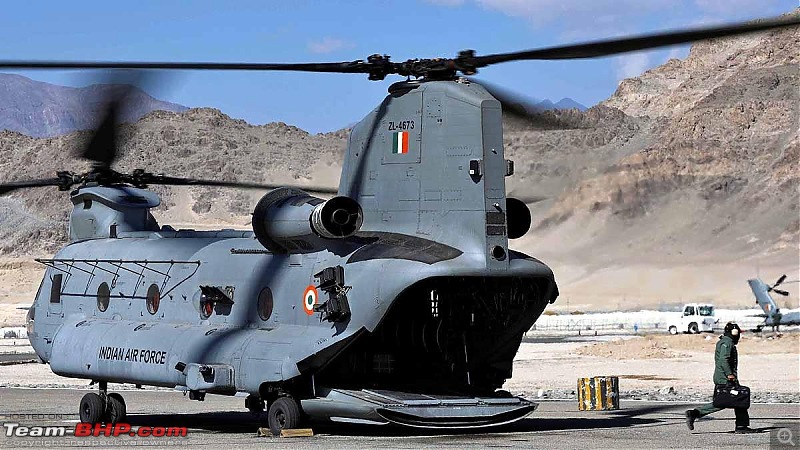 Despite being one of two largest helicopters in production the Chinook is surprisingly fast at 315 kmph and due to its carrying capacity has a combat radius of action of 370 kms and the ability to operate from high altitude landing spots up to 18,000 feet. Because of its high power to weight ratio it can climb at a very respectable 1500 feet per minute. These speed parameters are like a Tata truck racing like a AMG car. 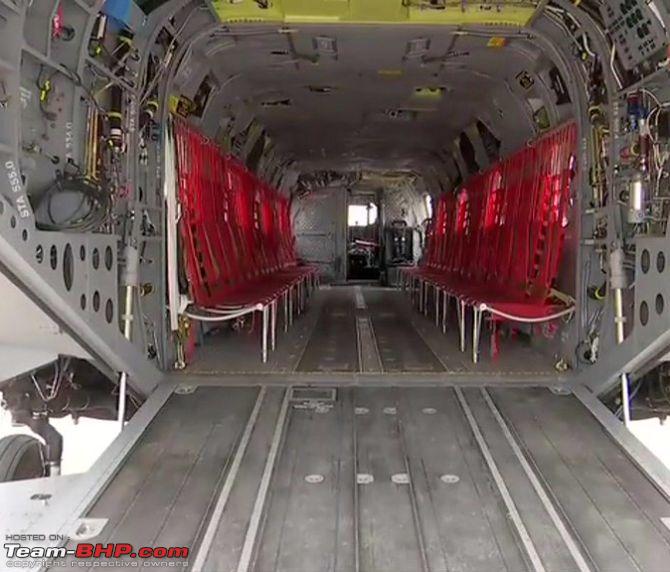 The Chinook carries a payload of 55 troops in a tight squeeze or 10 tonnes of payload. Its large ramp permits vehicles and field guns to be rolled in. For a helicopter the cabin is cavernous at 30 feet in length and over 8 feet in width. LIGHT MULTI-UTILITYBy its definition a helicopter is first a utility maid of all work kind of aircraft. No wonder that the early helicopters of the 1950s were all tailored around the light utility transport role. That is where India went in, with foresight, to produce the French Alouette III which with improvements is still in production as the HAL Chetak. It is a testimony not only to the versatility of the French design but also to our foresight of picking the right machine. A light utility is like the multi-purpose Maruti Omni van or Ecco! HAL Cheetah World's highest, high-altitude helicopter 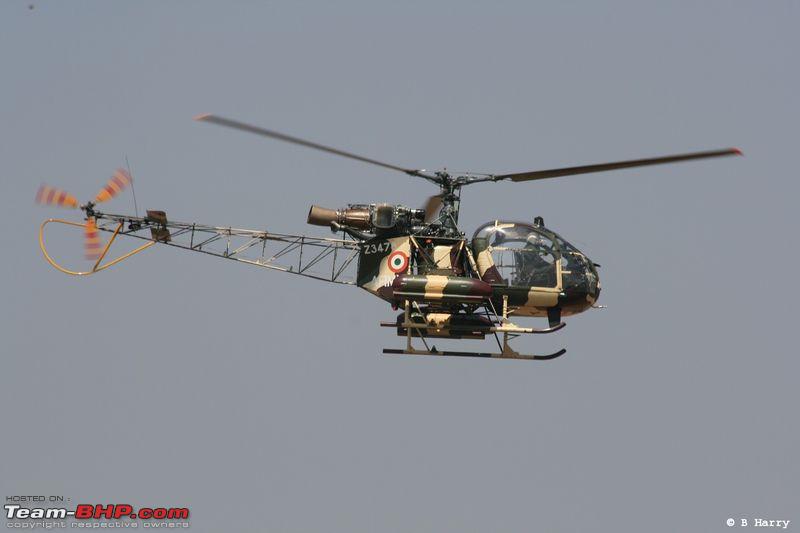 To fulfill our unique need for a helicopter to transport troops, supplies and weapons to manned border points at 15,000 to 20,000 feet in the Himalayas we needed a machine the likes of which did not exist - to carry a payload of 250 to 500 kgs to 17,000 to 20,000 feet, land, hover, pick up return cargo/troops, take-off at that altitude and return back. We need a machine to guard the highest most hostile border in the world. To fulfill that Aerospatiale designed the SA315 which we named Cheetah which is till today holds the altitude record for helicopters. 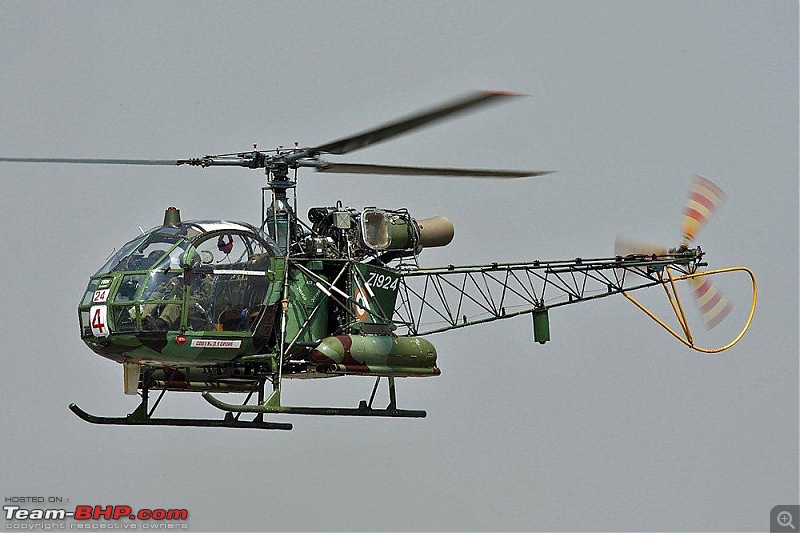 Capable of transporting upto 4 troops or 1000 kgs of fuel+payload the aircraft is powered by a derated turboshaft that can run at its full derated output at a shocking 55 degrees C at sea level. It is now being replaced in part by the Dhruv and will be replaced by the LUH {described below}. The Cheetah is used for high altitude transport and armed reconnaissance. HAL LUH {Light Utility Helicopter} India's replacement for the Cheetah  Following up on the success of Indian designs such as Dhruv, Rudra and Prachand HAL went ahead with the Light Utility Helicopter {LUH} fundamentally a modern, larger and more agile version of the Cheetah to serve both as our primary very high altitude chopper as well as our multi-purpose general light helicopter to replace both the Cheetah and Chetak. The LUH is a wholly Indian design developed without any foreign partner. A very encouraging sign of our aeronautical industry maturing. 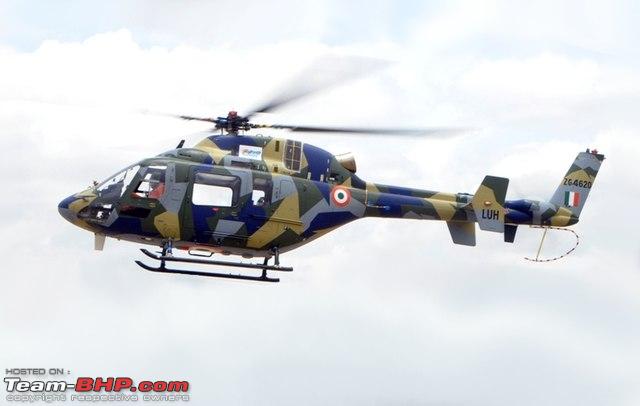 The LUH will be deployed for a host of roles such as - very high altitude transport, armed reconnaissance, forward air control, rescue, border patrol, flight training, geo-physical surveys and more. It seems like we have a winner on hand with the Army and IAF having expressed a need for 187 of these nimble machines. They carry a load of six fully equipped troops or a slung cargo of 1000 kgs to altitudes of 20,000 feet. 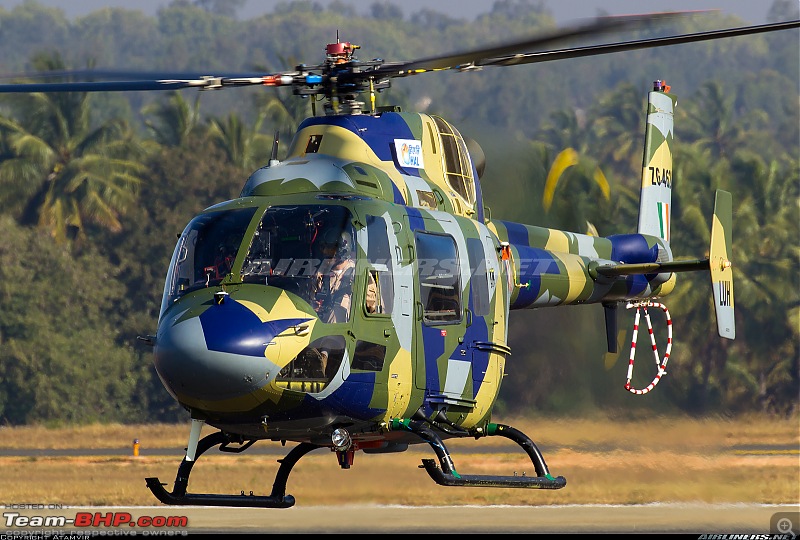 The LUH has a maximum take-off weight of 3.12 tonnes a payload of 1.0 tonnes and a top speed of 260 kmph. With a half tonne payload it can fly 350 kms. Operating ceiling is above 21,000 feet, probably higher. It is powered by a HAL-Turbomecca Shakti turboshaft derated from ~1384shp to 1070 shp to support power adequacy at the very high altitudes the helicopter needs to operate at in Ladakh, Siachen, Himachal borders etc. HAL-Turbomecca Shakti Turboshaft helicopter Engine 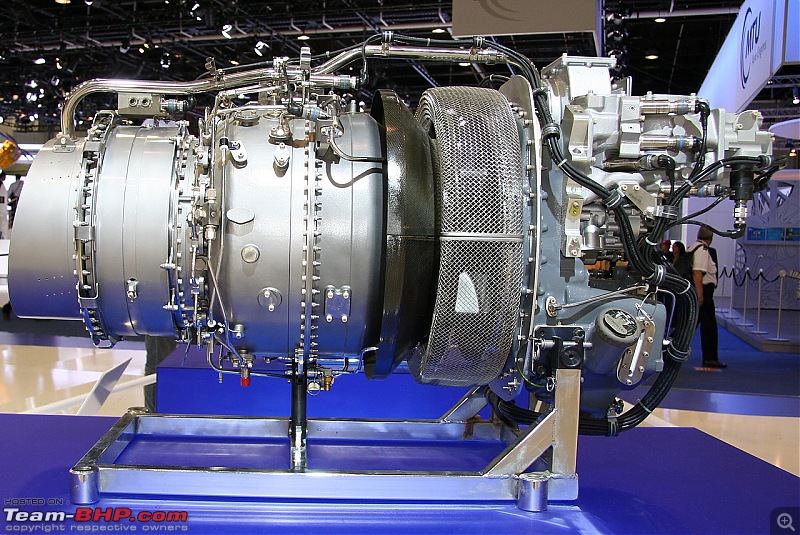 No treatsie on helicopters of India can be complete without a word on the Shakti turboshaft developed jointly by Turbomecca and HAL for a long line up of Indian helicopters - Dhruv, Rudra, Prachand & LUH. The Shakti is a evolved version of the French TM333 engine that was used on the early Dhruv Mark 1. The Shakti develops 1258 shp to 1384 shp in different variants. Over the next 20 years we may manufacture over 1000 of these engines. A turboshaft engine is a small jet engine with a power extraction turbine at the rear that like a turbo charger (of a car) draws out the energy of the hot fast flowing exhaust gases and converts it through a gear box into the rotation of the rotor blades. Most turboshafts extract the bulk of the kinetic energy and push it into the rotor gearbox and a small remainder of the kinetic energy goes out as hot fast free flowing gases that augment the forward speed in flight. That covers the helicopters serving currently with the Army & the IAF. Next comes the Navy & the Coast Guard ---:::--- Last edited by Aditya : 3rd November 2022 at 18:18. Reason: As requested |
| |  (73)
Thanks (73)
Thanks
 |
| The following 73 BHPians Thank V.Narayan for this useful post: | 2himanshu, Acharya, ads11, akshye, Ankur@VNS, anra, aravindhunt, AROO7, arunabh2424, Arun_S, ashpalio, Ashwin Morey, badboyscad, BalaSNKL, Batfreak, beejay, binge_rider, BRV, CarManMotorcycl, Contrapunto, dailydriver, DetonatoR, DevilzzzzOwn, DiMaGo, dragracer567, ellip5i5, Fuldagap, Gannu_1, GTO, gunin, Herschey, IcarusMan, Jeroen, KANNURAN, kutts, lapis_lazuli, libranof1987, Madrasin_selvan, manjubp, neel@makrand, NirmalK, Prakritij, Precision, PWRUP, Ranyguru2, Raul258, RaviK, RGK, Route66, sagarpadaki, saikarthik, Samarth 619, shikha_roy, Shome, Shreyans_Jain, Simhi, skanchan95, skx007, SmartCat, somspaple, Spaced Out, srvm, theqca, TSIboy, v12, vaasu, vamsi.kona, varunswnt, Vishal.R, Voodooblaster, whitecloud, whitewing, ysjoy |
| |
| | #2 |
| Distinguished - BHPian  Join Date: Aug 2014 Location: Delhi-NCR
Posts: 4,078
Thanked: 64,556 Times
| Re: Indian Aviation: Helicopters of the Indian Armed Forces ANTI-SUBMARINEAnti-Submarine Warfare {ASW} Helicopters use specially-designed sensors and weapon systems to singlehandedly find, track and destroy submarines. A helicopter having no contact with the sea becomes next to impossible for a submarine to detect especially if the helicopter is listening and tracking the submarine in passive mode. A ship borne ASW helicopter, especially when operating as a pair adds immeasurably to a warships anti-submarine offensive competence. India operates 50 shipborne ASW helicopters. Sadly this number has not changed much for 20 years. :-( I wish we had about 75. The primary weapon for an ASW helicopter is the light anti-submarine homing torpedo typically weighing ~300 to 500 kgs, with a warhead of 45 to 75 kgs, a speed of 45 to 60 knots and a range of about 8 to 13 kms. These are indicative figures to give readers a rough idea. Westland Seaking World's first ASW helicopter system 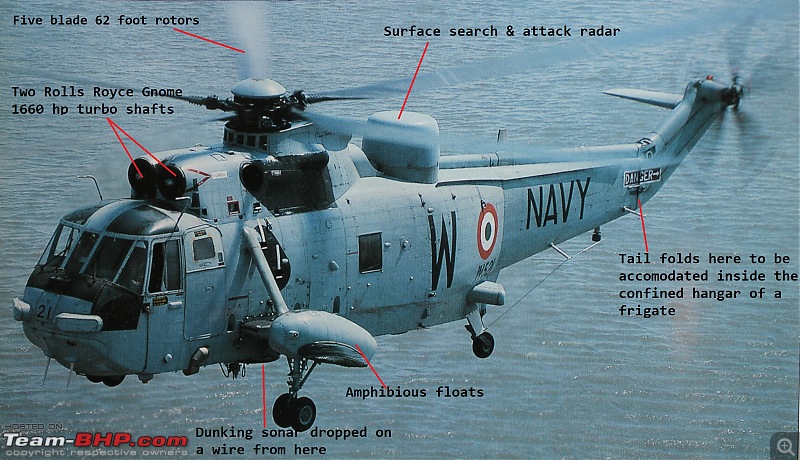 Our first real offensive helicopter was the British Westland Seaking in itself a development of the ever green American Sikosrky SH-61. The Seaking was the first helicopter in the world to be designed around being an independent weapon system by itself not requiring sensory or command-control support from a mother ship. The Seakings were a sensor, processor and weapons delivery platform. The main sensors are the surface search radar and dunking sonar. The primary weapon is a light 324mm anti-submarine homing torpedo. Alongwith the Kamov Ka-28 it remains the mainstay of our ASW helicopter strength 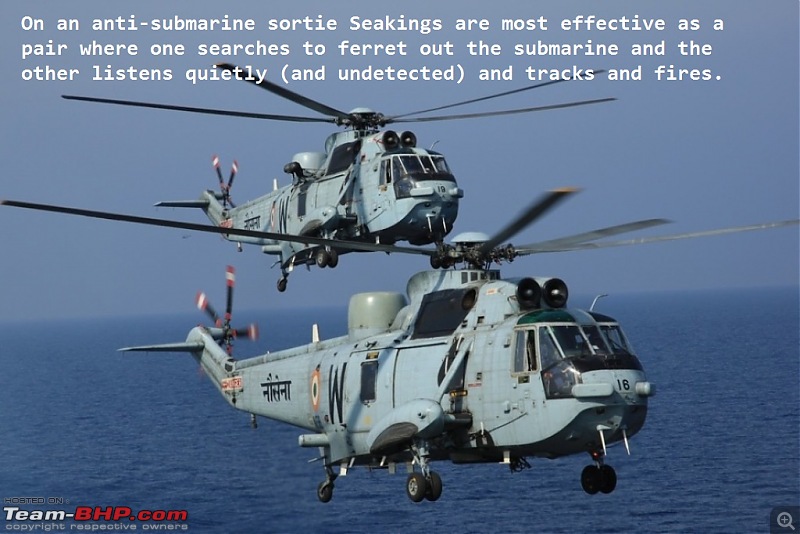 The sonar is dropped with a holding cable and a data transfer wire dozens of metres into the ocean where it then searches for submarines either through passive listening (of propeller noise) or active acoustic pinging. The crew inside the helicopter listen for the enemy submarine and once tracked and identified can launch homing torpedoes or drop depth charges. Indian Seakings have a sonics processing system which through data links enables them to listen into signals from sonobuoys dropped by other friendly aircraft on the same search & hunt mission. Sonobuoys are one time use sonars. Kamov Ka-27/28 USSR's Anti-submarine bee 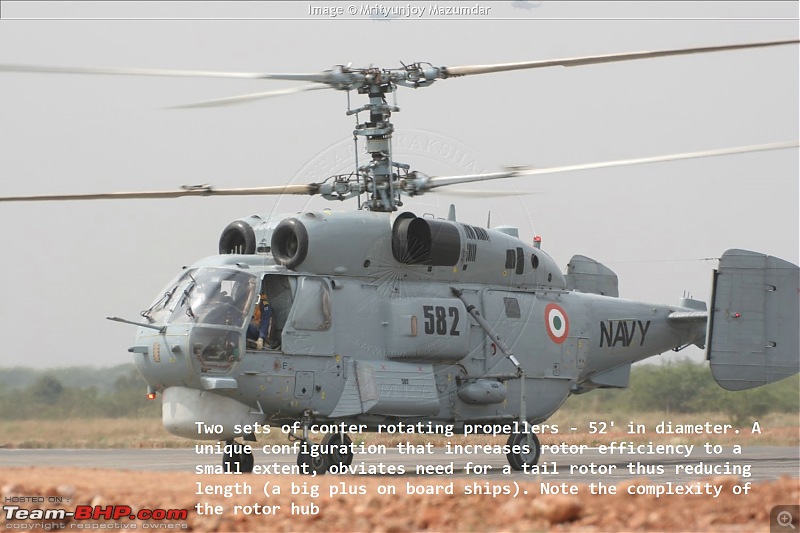 The Kamov Ka-28 {export variant of the Ka-27} was acquired to augment the Seaking fleet and to get around the sanctions imposed by USA after Pokhran-II in 1998. Comparable in ability to the Seaking the Ka-28 has served us well. Like all ASW helicopters it uses active & passive dunking sonars, sonobouys and magnetic anamoly detectors* to search for submarines and homing torpedoes to knock them out. Its contra rotating rotors are unique feature of all current Kamov designs. 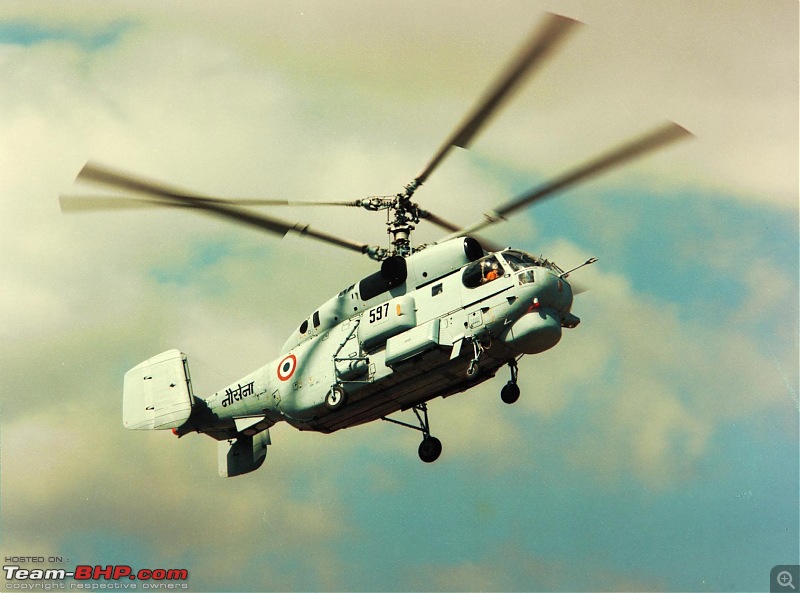 In the photo above we see the chin mounted radar, the contra rotating props, the large 'war room' cabin and the two powerful 2250 shp Isotov turboshafts on the roof. Its armament is typically one light ASW torpedo and 4 depth charges or 8 depth charges. I have a soft spot for the Ka-28s. If the USSR had not broken up this machine could have been our standard shipboard chopper for both ASW and ship to shore troop assault work. *A magnetic anomaly detector picks up the disturbances in the earth's magnetic field caused by any large moving steel object. It is a short range detection device. Sikorsky Seahawk MH-60R World's most potent ASW helicopter 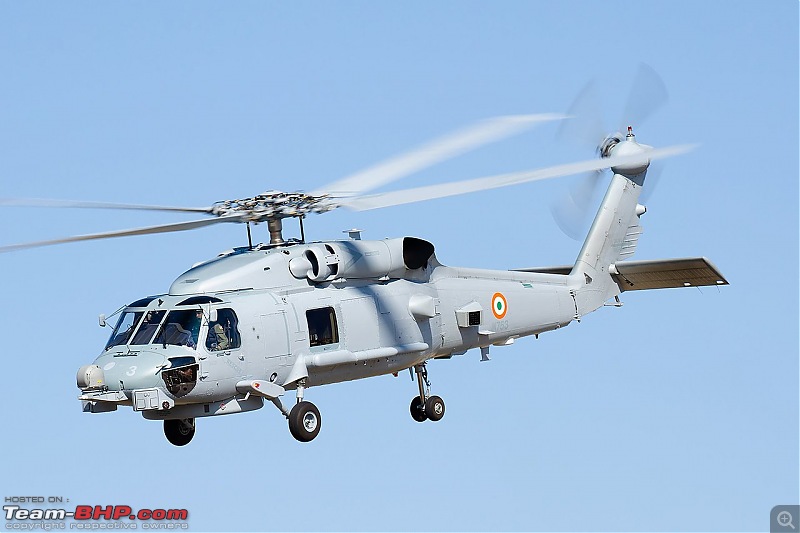 The MH-60R is the new incoming standard ASW ship borne helicopter of the Indian Navy. We have ordered 24 of which a few have been delivered. The Sikorsky MH-60R is by most counts the world's most potent ASW helicopter with a proven track record of reliability and lethal effectiveness. Powered by two GE turboshafts developing 1900 shp each which give the machine a maximum take off weight of 8 tonnes in ASW mode, a speed of 270 kmph and a range of 800+ kms. 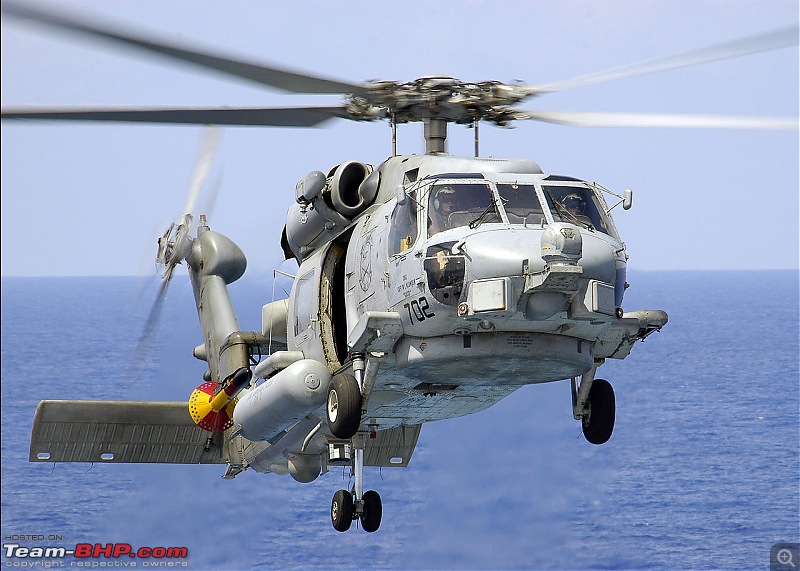 The yellow-red device is the magnetic anomaly detector. Forward Looking Infra-red optical sensor on the nose and the multi-mode radar under the chin. Typical armament is two light weight ASW torpedoes and upto 8 Hellfire laser guided short range {11 kms} air-to-surface missiles. 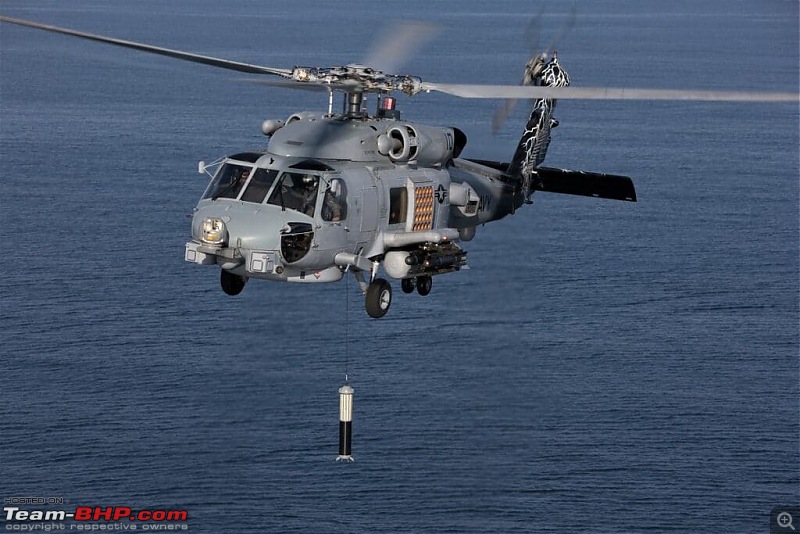 Submarine searching dunking sonar being lowered into the sea. Expendable one time use sonobuoys in the orange stack. Both can be used to search for submarines in passive {listening quietly} or active {pinging} mode In terms of electronics the MH-60R bristles with a dunking sonar {seen above}, a magnetic anomaly detector {seen above}, multi-mode surface search & attack radar, forward looking infra-red married to a laser range finder, decoys, missile warning device, periscope detecting radar, and a electronic warfare suite, all-weather & night navigation suite and secure datalink communications package amongst others. :-) The miniaturization of electronics means that a 8-tonne MH-60R helicopter carries more electronics with greater capabilities than a 40-tonne long range maritime submarine hunting aircraft could carry only 30 years ago. Naval Dhruv 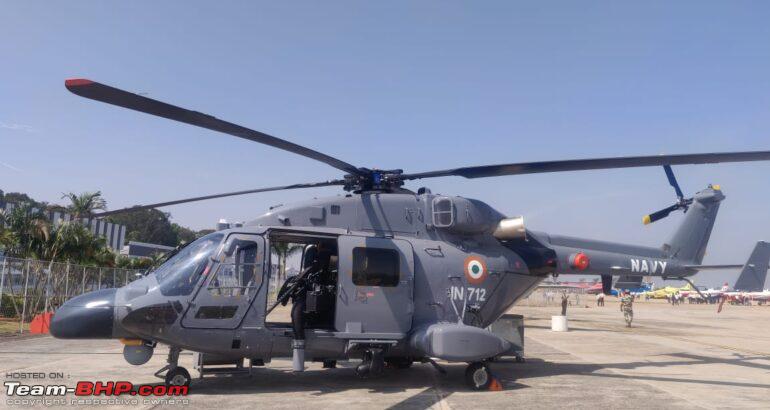 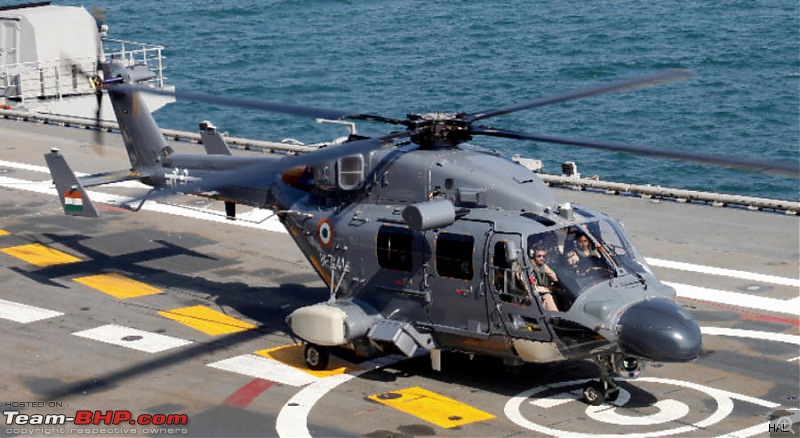 An attempt to build a shipborne Naval Dhruv for the Indian Navy. It is under development and testing. It could mature into a small ASW 'copter for small ships if we do it right. It's exact configuration, weapons fit is not clear except that it carries an advanced surface search radar and might be fitted with hardpoints that can lift two lightweight heliborne torpedoes. NAVAL PATROL & UTILITYHAL Chetak India's first license built helicopter; still in production 60 years on. 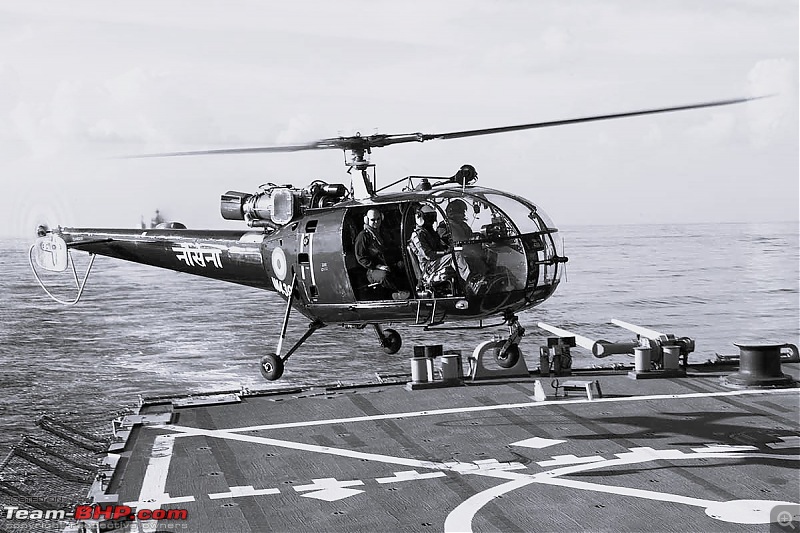 The HAL Chetak, erstwhile Aerospatiale Alouette III, remains in production and operations as India's all purpose light utility helicopter. In the Navy it is used for patrol, air to sea rescue, anti-piracy operations, training, hydrographic surveys, transport to ships at sea, and every conceivable role. Our maid of all work. It is a testimony to Aerospatiale's design of both the helicopter and the engines that it is production today at HAL 61 years after first donning Indian colours and 63 years after its first flight. Eventually it will get replaced by the LUH described in the post above. COAST GUARD PATROL & RESCUEDhruv Mk 3 Coast Guard Mainstay of India's Coast Guard Patrol 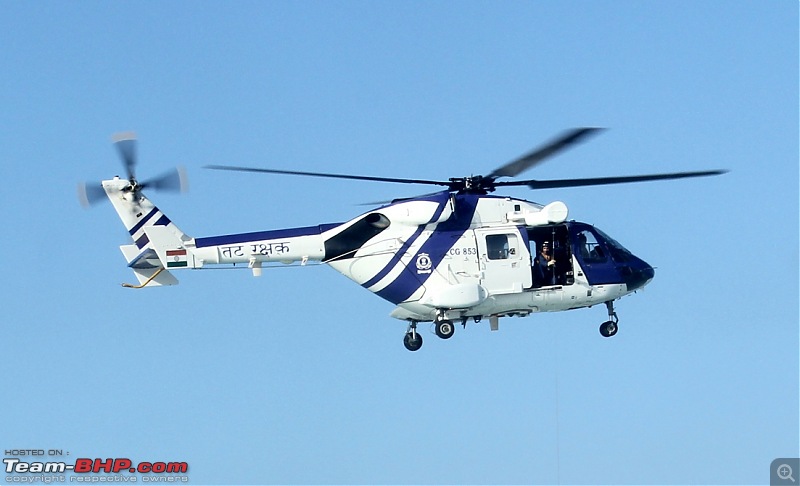 One of the largest users of sea going Dhruv's is the Indian Coast Guard with 15 in service. The Coast Guard's Dhruv's perform surveillance of our EEZ {Exclusive Economic Zone} while operating from the heli-decks of Coast Guard offshore patrol vessels, anti-piracy and anti-terrorism patrols, air-to-sea rescue operations and pollution containment of oil spills. They are very busy machines. All except one are Mk 3 versions with uprated HAL-Turbomeca Shakti engines and a glass cockpit. 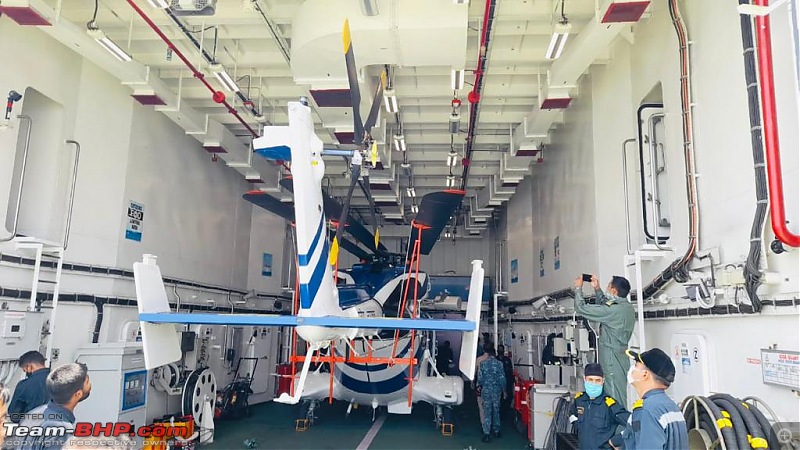 The cramped confines of a hangar on an offshore patrol vessel. Note the slim clearance on all sides and the folded main rotor blades. 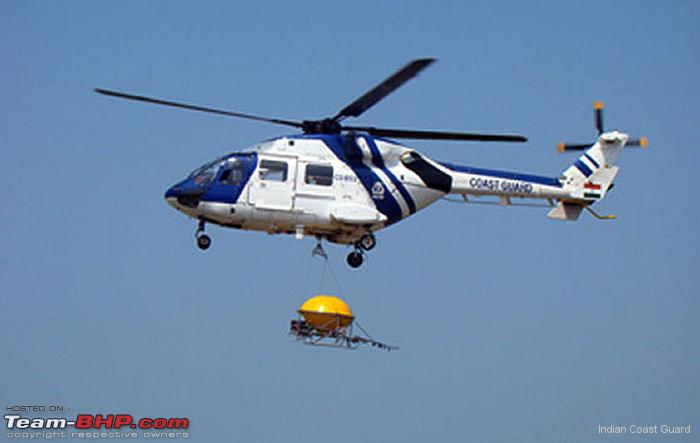 Oil spill containment spraying. The coagulated oil is then sucked up by a Coast Guard ship. The size, weight, payload, endurance and power of a Dhruv makes it an ideal platform for all kinds of Coast Guard and patrol duties. AIRBORNE EARLY WARNINGAEW stands for Airborne Early Warning a facility much needed by a fleet at sea to look far ahead and around for air and surface assets of the adversary including incoming missiles at long ranges and direct attacks against them. AEW is almost always now performed by an aircraft, fixed wing if you are the US or French Navy or helicopter based in case of China, India & UK. Kamov Ka-31 Eyes of the fleet 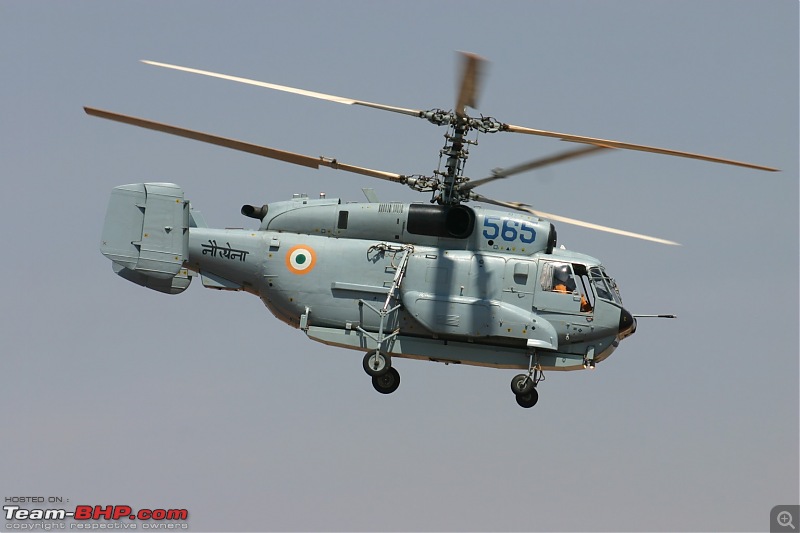 The Kamov Ka-31 is a unique helicopter in that it is one of two helicopter platforms in the world that perform the AEW role. When used at altitude, the radar on the Ka-31 allows the operators to detect and track targets and distinguish between friendly and hostile aircraft much farther away than a similar ship based radar. Note the flat radar stored horizontally flush with the underside of the fuselage. That radar is 6 metres in length and 1 metre in width. A rather big radar for a helicopter. Note the coaxial main rotors which rotate on opposite directions. This design, though complex, puts more motive power into the main rotors and by eliminating the tail rotor makes the machine more compact which is an asset in shipborne operations. 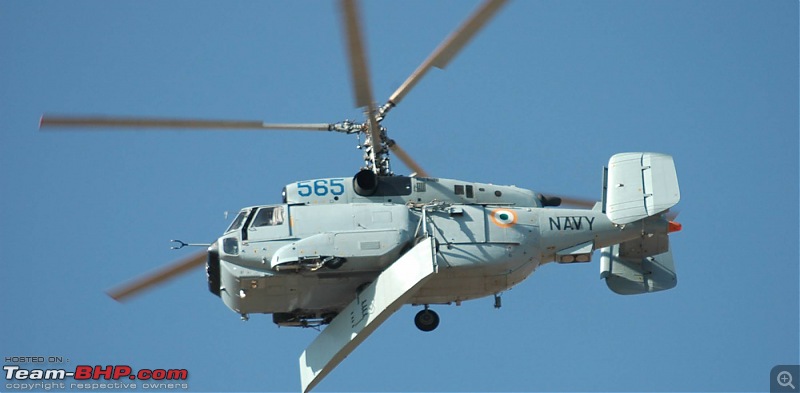 The Ka-31 has its long range search & track radar mounted underneath the fuselage. When stowed it lies flat horizontal flush with the underbelly and when deployed opens up vertically. This helicopter fitted with advanced avionics for command & control has an patrol endurance of about 3 hours. The radar can simultaneously track 40 targets at a time from sea level to 11,000 feet altitude and can pick up an aircraft at ~110kms and a ship at ~200kms. Information it cannot process in real time it transfers to a sip via a secure data link. Future of Helicopters 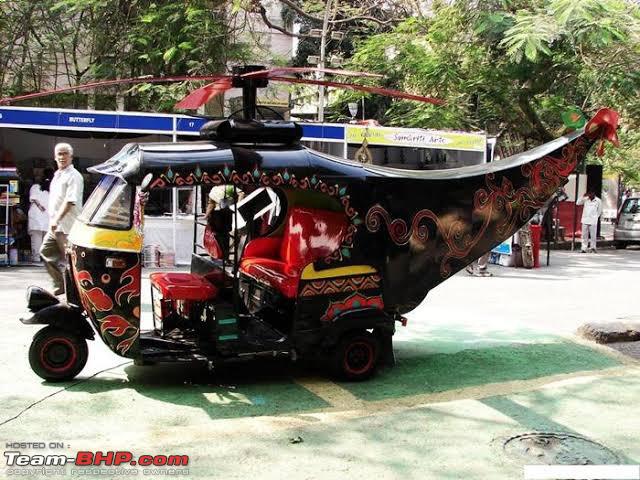 Our next break through design... JAIHIND Sources/References: Wikipedia pages History of Indian Aviation by Pushpinder Singh Modern Combat Helicopters by Bill Gunston & Mike Spick IAF Helicopters by Wing Commander B.S.Nijjar Jane's All the World's Aircraft, 2011 edition Last edited by V.Narayan : 2nd November 2022 at 19:27. |
| |  (102)
Thanks (102)
Thanks
 |
| The following 102 BHPians Thank V.Narayan for this useful post: | Acharya, ads11, AMG1, amoi, anandhsub, Ankur@VNS, anra, AROO7, Avinash_R, A_Abhiraam, badboyscad, BalaSNKL, Batfreak, beejay, Bhupi_BHP, binge_rider, BRV, CarML, catchjyoti, charanreddy, Contrapunto, dailydriver, DevilzzzzOwn, DiMaGo, download2live, dragracer567, ellip5i5, FiatDiesel, Fuldagap, Gannu_1, Gansan, GJ01, GTO, gunin, Herschey, IcarusMan, IP_Man, Jeroen, jsrakkar, JustStarted, Kandisa, KANNURAN, kaps454, kraken, kutts, Lalvaz, lapis_lazuli, libranof1987, maddy42, Madrasin_selvan, mpksuhas, naveenvenkatesh, neel@makrand, NetfreakBombay, NirmalK, no_fear, peterjim13, PGA, Prakritij, Precision, Ranger747, Raul258, RaviK, RGK, RohanDeshmukh, Romeo_Mike, Route66, Rshrey22, saikarthik, shikha_roy, Shome, shreyak_ss, Shreyans_Jain, sierrabravo98, Simhi, skanchan95, skx007, Skyline_GT, SmartCat, sridhar-v, SRISRI_90, srvm, Sudeep Lakhotia, sukhbirST, TheCatalyst, Thegermanbadger, Torino, TSIboy, Tucker48, v12, vaasu, vamsi.kona, varunswnt, venkyhere, VijayAnand1, Vishal.R, vivekkp, Voodooblaster, whitecloud, whitewing, windiesel, xsrahul |
| | #3 |
| Team-BHP Support  | Re: Indian Aviation: Helicopters of the Indian Armed Forces Thread moved out from the Assembly Line. Thanks for sharing! |
| |  (4)
Thanks (4)
Thanks
 |
| The following 4 BHPians Thank Aditya for this useful post: | GTO, RRM, srvm, V.Narayan |
| | #4 |
| BHPian Join Date: Jun 2021 Location: Noida
Posts: 255
Thanked: 514 Times
| Re: Indian Aviation: Helicopters of the Indian Armed Forces Very comprehensive and informative details about military helicopters sir. Adding my bit for Seaking helicopters is that the older ones were Seaking 42/42A while the new ones which are also being phased out are Seaking 42B/42C. Seaking 42b has weapons and sensors with capability to carry 2 depth charges or 2 torpedoes or 2 anti ship missiles. It can also be used to carry 6000kg cargo but all these are after removing some other items. Seaking 42C is mainly the same but without any sensors/weapons and is used for carrying commandoes or cargo. Both types also have a winch which is used for search and rescue. Spent my whole lifetime in 42Bs while embarking (as weapon & sensor operator) onboard aircraft carriers Vikrant, Viraat or other helo carrying ships. The sensors and weapons were really impressive. |
| |  (6)
Thanks (6)
Thanks
 |
| The following 6 BHPians Thank sukhbirST for this useful post: | ads11, anandhsub, Fuldagap, Gansan, libranof1987, V.Narayan |
| | #5 |
| Senior - BHPian | Re: Indian Aviation: Helicopters of the Indian Armed Forces As always, a very well compiled thread and it was a treat to read Sir. If I may add to the already comprhensive list, The Navy also operates 5-6 ex-US Navy Sikorsky UH-3H Sea Kings that were acquired along with the USS Trenton/INS Jalashwa. 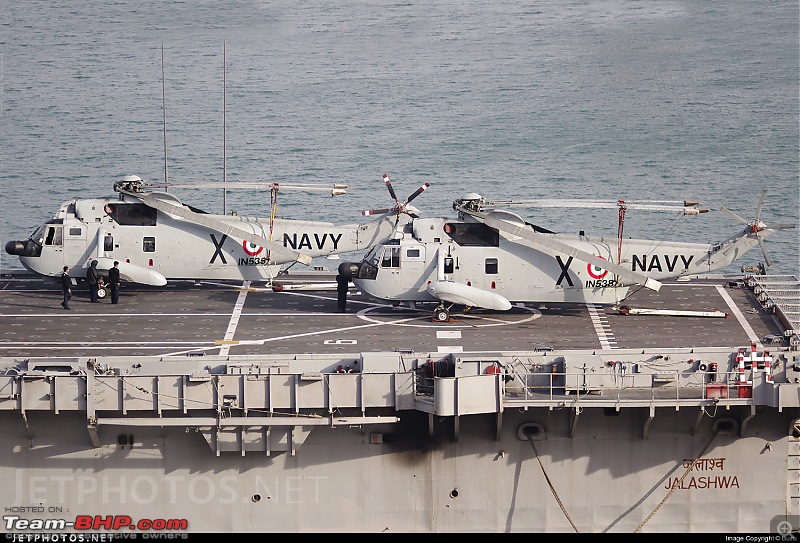 |
| |  (15)
Thanks (15)
Thanks
 |
| The following 15 BHPians Thank skanchan95 for this useful post: | ads11, anra, badboyscad, Batfreak, catchjyoti, dragracer567, ellip5i5, Fuldagap, IP_Man, Lalvaz, libranof1987, mpksuhas, Simhi, V.Narayan, xsrahul |
| | #6 |
| BHPian Join Date: Jul 2011 Location: Mumbai
Posts: 41
Thanked: 75 Times
| Re: Indian Aviation: Helicopters of the Indian Armed Forces Very comprehensive thread - one question, do we still have the mighty Mi-26 in service? |
| |  (1)
Thanks (1)
Thanks
 |
| The following BHPian Thanks bhairavp for this useful post: | Fuldagap |
| | #7 |
| BHPian Join Date: Sep 2019 Location: MH04
Posts: 186
Thanked: 567 Times
| Re: Indian Aviation: Helicopters of the Indian Armed Forces A thoroughly enjoyable read as always Sir. I would have loved a mention of the Mi-26 as well. Its a shame the mighty giants in the IAF's inventory are no longer flyworthy due to lack of maintenance/spares. 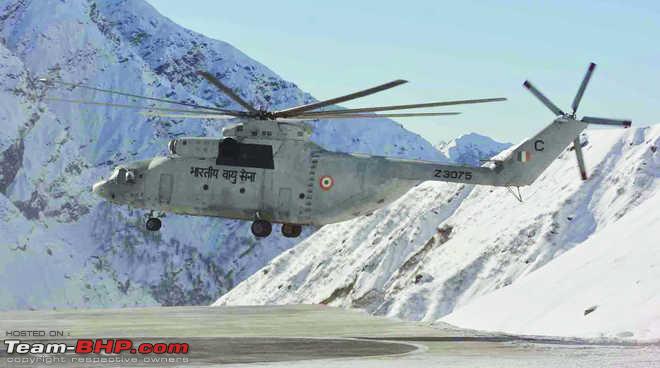 Image Credit: Respective owner(s) Last edited by Romeo_Mike : 3rd November 2022 at 11:59. |
| |  (9)
Thanks (9)
Thanks
 |
| The following 9 BHPians Thank Romeo_Mike for this useful post: | amoi, catchjyoti, Contrapunto, Fuldagap, mpksuhas, saikarthik, V.Narayan, Vkap257, xsrahul |
| | #8 |
| BHPian Join Date: Apr 2011 Location: --
Posts: 261
Thanked: 1,337 Times
| Re: Indian Aviation: Helicopters of the Indian Armed Forces Thanks for such a fantastic read and great info. Mi17 is close to heart due to various reasons. It is indeed outstanding. May I post a piece of article related to a great narration by an ex civil servant (ex DGP of J&K) ?! King Kahlon of Kashmir |
| |  (3)
Thanks (3)
Thanks
 |
| The following 3 BHPians Thank Fuldagap for this useful post: | sukhbirST, V.Narayan, whitewing |
| | #9 |
| Team-BHP Support  | Re: Indian Aviation: Helicopters of the Indian Armed Forces
We have a bunch of unmanned helicopters (also called helicopter drone or rotary wing UAV) in the pipeline. DRDO is partnering with private companies for this venture. When desi helicopter drones hovered with pride at the India Pavilion https://www.deccanherald.com/state/w...on-948072.html 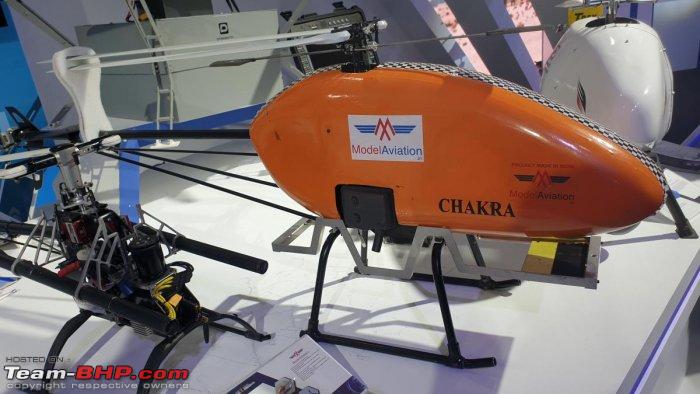 However, this is just in preliminary stages. Fixed wing UAVs have clear advantages of speed. But it is unclear what a rotary wing setup has over typical quad-copter setup for an UAV/drone - it can carry heavier payload perhaps. Last edited by SmartCat : 3rd November 2022 at 12:47. |
| |  (4)
Thanks (4)
Thanks
 |
| The following 4 BHPians Thank SmartCat for this useful post: | ads11, V.Narayan, Vishal.R, xsrahul |
| | #10 |
| BHPian Join Date: Nov 2012 Location: Hyderabad
Posts: 608
Thanked: 872 Times
| Re: Indian Aviation: Helicopters of the Indian Armed Forces Kamov's contra-rotating props are always such a treat to watch. It was only recently that I found a documentary in Youtube on how it works. Soviets seemed to have loved that mechanism. They had it in the Tu-142 Bear as well. Its interesting that in a recent article, I noticed that the USAAF is bringing this back into consideration for one of their new helicopters |
| |  (1)
Thanks (1)
Thanks
 |
| The following BHPian Thanks Contrapunto for this useful post: | V.Narayan |
| | #11 |
| BHPian | Re: Indian Aviation: Helicopters of the Indian Armed Forces Comprehensive and packed with the right photos and great info as always sir. Interestingly I get to see most of the our Navy Choppers including the new MH60 here in Cochin. Did you miss the Mi-25 in the transport choppers list or has it been completely phased out? Interesting to read that the HAL Chetak is still in production. Are new choppers being built for our Armed Forces? I recently read about a Chetak being gifted to Mauritius. Likewise, we had gifted Mi-35s to Afghanistan - looks like they are now with Taliban. Last edited by peterjim13 : 3rd November 2022 at 14:57. |
| |  (3)
Thanks (3)
Thanks
 |
| The following 3 BHPians Thank peterjim13 for this useful post: | Fuldagap, roadster07, V.Narayan |
| |
| | #12 |
| BHPian Join Date: Nov 2019 Location: Delhi / Dublin
Posts: 97
Thanked: 178 Times
| Re: Indian Aviation: Helicopters of the Indian Armed Forces A very detailed and comprehensive overview of these formidable machines and marvels of engineering. While "Apache AH-64" might have seen a lot of action due to US policy of moving troops around the globe, I personally feel that Kamov Ka-52 "Werewolf Hokum" is superior in terms of design and mechanics. While Kamov might have not seen as much action as Apache, the idea of removing the tail rotor (which causes maximum fatalities in helicopter) and adding another rotor was radical, and to an extent ingenious. Your thoughts and guidance  |
| |  ()
Thanks ()
Thanks
 |
| | #13 | |
| BHPian Join Date: Oct 2012 Location: Bangalore
Posts: 561
Thanked: 1,592 Times
| Re: Indian Aviation: Helicopters of the Indian Armed Forces Always look forward to the threads on the armed forces and aviation topics from you. There is so much information packed in them. Thank you for taking the effort and the time for compiling these threads! Quote:
If so, then wouldn't the French be constrained considering they have only one aircraft carrier? | |
| |  ()
Thanks ()
Thanks
 |
| | #14 | |||||
| Distinguished - BHPian  Join Date: Aug 2014 Location: Delhi-NCR
Posts: 4,078
Thanked: 64,556 Times
| Re: Indian Aviation: Helicopters of the Indian Armed Forces Quote:
Quote:
Quote:
Quote:
Quote:
The Grumman Hawkeye E-2 taking off from the catapult of the French carrier Charles de Gaulle. Notice the Naval Rafale in the background. Last edited by V.Narayan : 3rd November 2022 at 15:34. | |||||
| |  (7)
Thanks (7)
Thanks
 |
| The following 7 BHPians Thank V.Narayan for this useful post: | Fuldagap, Lalvaz, saikarthik, skanchan95, sukhbirST, Vishal.R, whitewing |
| | #15 | |
| BHPian Join Date: Aug 2017 Location: Leeds
Posts: 959
Thanked: 2,308 Times
| Re: Indian Aviation: Helicopters of the Indian Armed Forces A pleasure as always to read your almanac like threads. Another fantastic entry! Quote:
One of the prototypes uses not only the contra rotating main rotors made famous by Kamov but also a pusher prop at the rear for near unheard of forward speed. Another contender uses a modernised version of the tiltrotor system made famous by the V22 Osprey. Obviously it remains to be seen which make it to final production. | |
| |  (3)
Thanks (3)
Thanks
 |
| The following 3 BHPians Thank ads11 for this useful post: | Contrapunto, sukhbirST, V.Narayan |
 |


